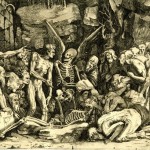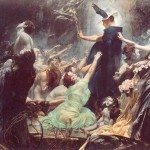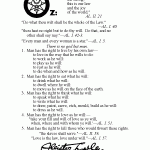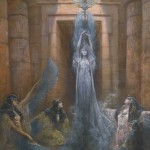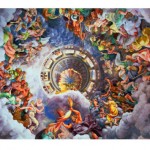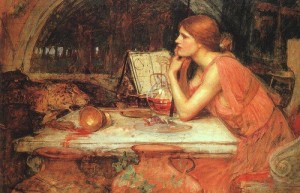 I don’t do cultural Paganism. I worship the Gods I’ve come to know. My commitments and priesthood is not bounded by cultures, but by contact. But some of that contact is with Deities that lie beyond culture.
I don’t do cultural Paganism. I worship the Gods I’ve come to know. My commitments and priesthood is not bounded by cultures, but by contact. But some of that contact is with Deities that lie beyond culture.
I’m not identified with the ancient Greeks, Romans, Egyptians, Celts, Norse, or even the Indians, even if I worship their Gods. Some might see this as eclecticism, but that is a bit too facile. If I have the fortune of knowing of a Deity through contact, why should I let culture or time be a limit on what I do? The contact is the important thing. However, this does not produce a pantheon that has the inherent balances and integrity that a single cultural pantheon does. I will have to look for those qualities elsewhere, and when striving for balance and completeness, I will have to use other means. Fortunately theurgy provides the resources.
Culturally centered Paganism, exemplified by the Reconstructionists, is a relatively new phenomenon. We can see in the Pagan-inclined members of the six hundred year long occult movement deep relationships with Deities from across European culture and history, and sometimes beyond. The history of the effort to work one ancient culture’s religious way as assiduously as the the Recons do, with its challenges of fragmented data, the tensions of scholarship, and the practicalities of modern worship, would be a tale worth telling.
Coming out of the magi, old school western magical practice, as I do, I inherited a polyphonous theological construct, as anyone who has studied the Golden Dawn would know. Inquiry and a sense of order eventually inspires the creation of some kind of coherent framework with which to understand the Gods. The framework I adopted was partly a result of studying the Qabalah of the magicians, and partly out of my study of the origins of the Bible in seminary. That and a sense of mischievousness and reclaiming led to my adoption of the name Elohim for ‘my’ core pantheon.
“Bereishit bara Elohim et hashamayim ve’et ha’aretz” is how the Torah starts. This is a line cribbed from the Enuma Elish, the creation story of ancient Mesopotamia, picked up by the Hebrews during their Babylonian Exile, in the Paris of its day. This lead to the insertion of the more philosophical first chapter of Genesis during one of the many recompilations of the Tenak, the Hebrew Bible. It is usually translated as “In the Beginning, God created the Heavens and the Earth…”, but any scholar of language knows that is not what it says. Contrary to contemporary interpretation (and prevarication), Elohim is plural. It means ‘the Gods’. So, this supposed tome of monotheism has as we would expect from history, a polytheistic root. A name for the ancient pantheon of the Hebrews, and of the Canaanite culture they came out of is ‘the Elohim’. Keeping my eye on that unpopular fact, I have adopted the name for the set of Deities I work with, especially in Their ‘highest’ or ‘core’ sense.
I have to make this distinction as I don’t shoe-horn the Greek, or Egyptian, or other Gods into the framework of the Elohim. It is the name I use for the set of abstract or Noetic Deities that lie behind or above the Deities of direct worship. (See previous post) There two key reasons from making this distinction. One has to understand and account for the deeper level of the Deities to be experienced when pushing past the culturally framed Deities we communally worship. This leads to clarity and coherence in practice. The other reason is that through knowing the fundamental set of Deities we can come to understand our own or ‘soul’ origins. This is called one’s series, and we will return to this later.
The magi or magicians inherited the use of the Qabalah from the Renaissance magi when they sought a polytheistic framework and cosmology they could use in a Christian culture. Pico, Reushlin, and later Agrippa each roughly appropriated the Kabbalah of the Jews, reinterpreting it in a Christian manner. It provided a detailed map of the cosmic process that was similar to the ancient Greeks but ‘not pagan’ since it was Jewish and theoretically older. That was, of course, not true. Kabbalah is a brilliant reinterpretation of Neoplatonism by and suitable for the Medieval Jews. But, long story short, it was an effective way to sneak Pagan Neoplatonism back into pseudo-orthodox practice suitable for quasi-Christians. The most elaborate form of this will much later incarnate as the Hermetic Order of the Golden Dawn, which uses the Qabalistic Tree of Life as its ritual and symbolic foundation. It was there that I inherited the Elohim.
Elohim is name I use for the set of the highest and most originary, most primordial level of Deities and the One itself. The One and Its Court, so to speak. A mage’s understanding of how the World is formed and how the Gods form It greatly determines the form and focus of practice.
The ancients start with the One. In the West the notion of creation ex nihilo, except amongst Christians, was considered absurd. For the East, this was not so much of a problem because the yogis experientially learned to access the Void. Shunyata, properly, is often a problem for westerners, but it is conceptually the Zero before the One. What It is exactly is a bit harder to put into words as only negative terms apply. It called ‘empty’ (sometimes ‘void’) in that it is empty of or without characteristics with which It may be perceived yet the mind, being of Its same essence, as the yogis discovered, can access it. I’ve come to think of it in mathematical, specifically geometrical, terms. Here it has to do with the modeling of form.
The clue for how this works came to me from the insights of physics which posit the origins of the Big Bang in the breakdown of the primordial cosmic symmetry, bringing about that massive explosion. I’m talking about the moment before that, when the symmetry was yet unbroken. Here all forms and their opposites are perpetually united, ever resulting in zero. Much as all numbers can be united with their negatives to produce zero (1 + −1 = 0, 2 + −2 = 0, etc.). So do all geometric forms and their inversions produce a kind of nothing. The sphere and the anti-sphere, the triangle and the anti-triangle, all result in a kind of ‘full’ emptiness because both are ‘there’ yet neither can manifest since the other is present. The One, or Kether to the Qabalists, is the first step after the symmetry break that creates the One, and there after, everything else.
About the One little more can be said than about the Void. However, that little is crucial. The One bequeaths its One-ness to everything that follows and from it we derive our entitative existence. Without the oneness of the One, nothing else could exist. Everything that is needs and thus inherits from the One some kind of unity to form itself into being. This is the great gift of the One to us all, our existence itself. Along with this crucial quality there may other properties of the One that we may posit. If you want the long list, go study the Neoplatonists. They theorized on this at length. My favorite is that of the great expositor of theurgy, Iamblichus of Chalsis, author of De Mysteriis, the cornerstone text of the Western magical tradition. He simply concluded that the primordial Deities were potentials in the One and manifest in the Noetic realm, the first emanation from the One.
These Noetic Beings are the ones of whom we can speak with some distinction, but exactly how is something of a problem. What is truly the primordial? For me it is time to turn back to geometry. Geometry is one of the great proving grounds. If it can’t be done by geometry, perhaps it should not be done…
The discipline of abstract geometry, the kind of geometry that would give Euclid headaches, tries to find out the fundamental rules of all types of geometry, Euclidian and non. It’s study has lead to a determination of the three principal and irreducible rules or forms that no system of geometry can dispense with. They are Contact, Overlap, and Part-Whole. These, in terms of fundamental forms, appear to be the three primordials.
When we turn to how magic is practiced over the world, we discover two weird congruences that show up everywhere. First, magic is generally divided into three branches designated by the same three colors, namely black, white, and red, although not everyone associates the colors in the same way. Secondly, they tend to be associated with three core strategies for the practice of magic, the focus on Wisdom, or Love (Compassion), or Power. Generally, worldwide, practitioners focus on one of these three as the key and driving influence, even primary value and method, of their practice.
For me, the three fundamental forms are the very same as the three primordial principals. Contact is also limit and it is only through limitation that Power manifests. Love is the Overlap of shared reality, the taking in of the Other, in profound loving acceptance. Wisdom is the recognition of the Part, and the Whole, and their Union.
In terms of the pantheon I am speaking of, after the One, the Primordial Being and Maker, then come the Three Powers that, with the Maker, form the World to come. They make the through combination. While the One holds the core unity, each of the Three combine for form the Second Three. Power and Love produce Harmony. Power and Wisdom produce Strife. Wisdom and Love produce Growth. This produces two sets of three or six, around one, the source. This is one of the fundamental shapes in our world. From this is derived the twelve around one, but that is a story for another day.
For now, it is in this idiosyncratic way I form the root of the pantheon I work and worship. It reckons with the history of our inheritance from the Renaissance and the appropriation of the Qabalah, its peculiar history in the origins of the Hebrew texts, the Neoplatonic underpinnings of contemporary Paganism, some physics and geometrical theory. Out of this comes a pantheon rooted in the apparent, at least to me, structures of being. I find it works, over decades of use, but of course, your mileage may vary. )O+


